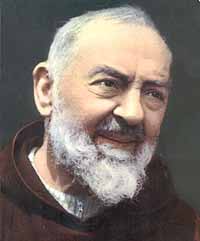|
|
(...) The life of Padre Pio was a gift from the Mercy of God to our times, and its full significance can only be appreciated by those who penetrate more deeply into the mystery of the Cross, and realise that this significance works at several different levels. Firstly, Padre Pio
was, and remains, a sign to all the world, the answer to all those who
say, "Lord, give me a sign, that I may believe". He represented
a point of contact with Eternity in his life. All who knew him could see
the Finger of God: here was a man of God, here was a prophet, a wonderworker,
a Saint. Yet we have not reached the crown of Padre Pio's sanctity, nor considered the particular significance which he has for us as Catholics trying to keep the Faith today. That crown was suffering. If being a good priest and monk was the foundation of his holiness, then his union with his crucified Saviour is the reason for his glory today. As the Holy Cross itself he has been first despised and then exalted. And Padre Pio's crucifixion was primarily a moral one. Though his physical sufferings were manifest to all, the suffering of his soul was hidden to most, and remains so today. Nevertheless, to appreciate the true significance of the Saint we must realise that it was his persecutions by men of the Church which constituted his real martyrdom. The calumnies, the false charges, the miscarriage of justice, the suspension of his priestly activities: these things nailed him more to the Cross than even the very wounds of Our Lord. It is related that when he heard of the first suspension inflicted upon him by misinformed Vatican authorities, Padre Pio wept inconsolably. When one of his brethren suggested that he be more resigned to the Will of God, he replied that it was not for himself that he wept, but for the souls who would be lost on account of this channel of graces being closed off to them. As for him, he explained, a more hidden life and greater moral suffering would mean the opportunity to advance more surely in grace and merit. In this episode we capture the highest significance of Padre Pio. The wonder-working graces he received were for the sanctification of others, but in his moral crucifixion lay his own path of sanctification. Now it is precisely this path that Traditional Catholics are called to take today, and it is only they who will truly appreciate the sign that God gives us in Padre Pio. It is the sign that we have in Archbishop Lefebvre, the Sign of the Cross. As it was for St. Pio and the Archbishop so it is for us: the sure path to holiness put before us is the Via Dolorosa of misunderstanding, calumny, controversy and contempt. If we are tempted to weaken at the prospect of this moral persecution at the hands of the ecclesiastical authorities and even of our own families and friends, we have only to look at the example of these two champions of the Mass and Priesthood and to consider their end. Today Padre Pio is vindicated, triumphant and glorious. One day the Archbishop's memory, cherished by the few who know, and despised by the many who know not what they do, will know a similar triumph on earth, God willing. In the meantime we know that the Way of the Cross they followed leads to Heaven, for "he who humbles himself shall be exalted". To persevere in grace and to attain to glory is the goal of our lives. To help us reach our goal we have their example and their powerful intercession. "
Home | Contact
| Mass Centres | Schools
| Pilgrimages | Retreats
|
Precious Blood Residence |
|||||||||||

